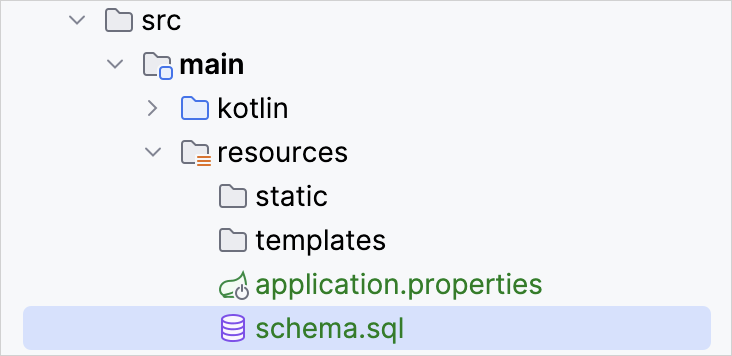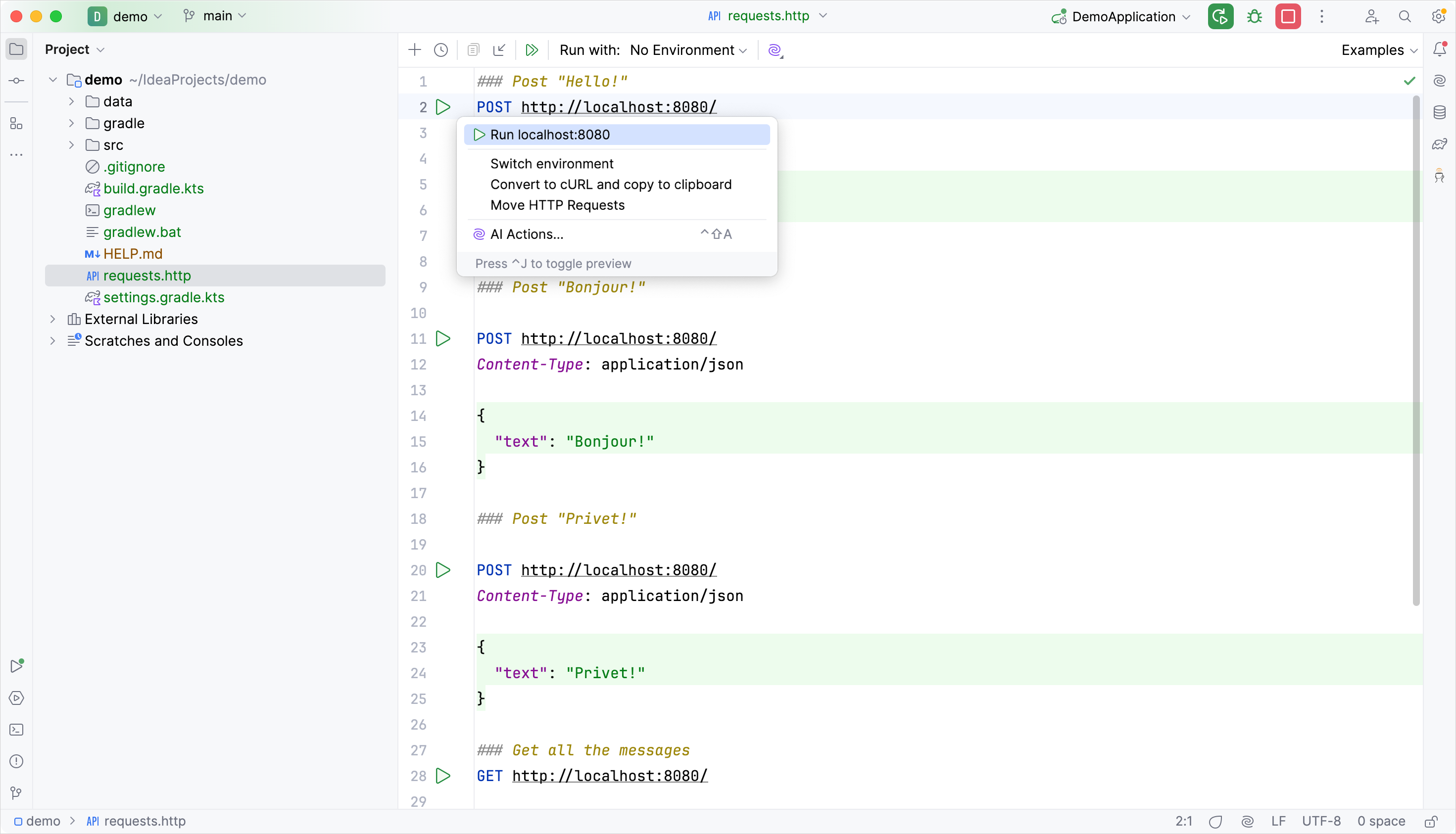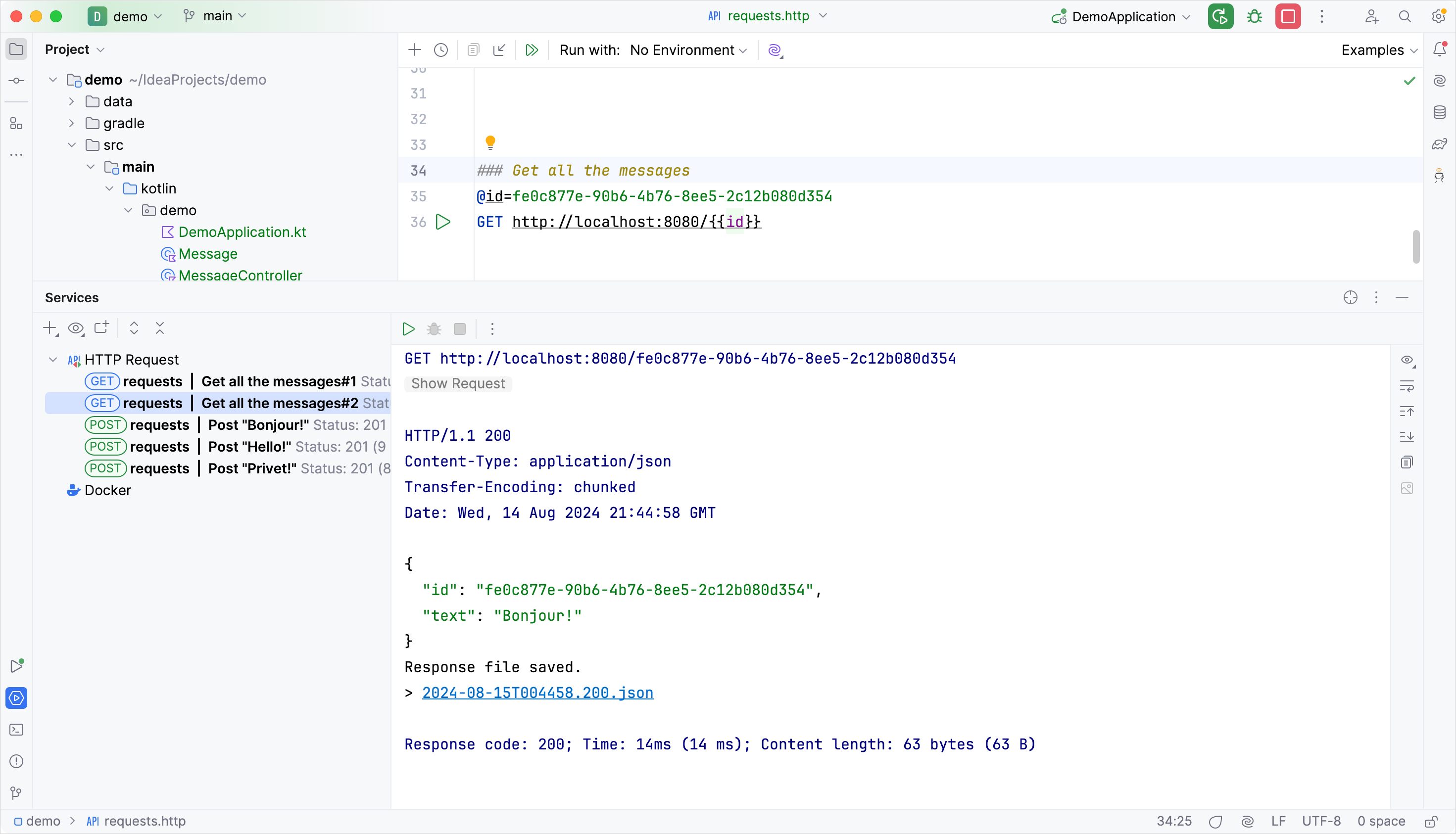为 Spring Boot 项目添加数据库支持
这是 Spring Boot 和 Kotlin 入门教程的第三部分。在继续之前,请确保你已完成之前的步骤:
使用 Kotlin 创建一个 Spring Boot 项目
向 Spring Boot 项目添加数据类
为 Spring Boot 项目添加数据库支持
使用 Spring Data CrudRepository 进行数据库访问
在本教程的这一部分,你将使用 JDBC 向你的项目添加和配置一个数据库。在 JVM 应用程序中,你使用 JDBC 与数据库进行交互。
为了方便起见,Spring Framework 提供了 JdbcTemplate 类,该类简化了 JDBC 的使用并有助于避免常见错误。
添加数据库支持
在基于 Spring Framework 的应用程序中,常见的做法是在所谓的 service 层中实现数据库访问逻辑——这是业务逻辑所在的地方。
在 Spring 中,你应该使用 @Service 注解标记类,以表明该类属于应用程序的 service 层。
在本应用程序中,你将为此目的创建 MessageService 类。
在同一个包中,创建 MessageService.kt 文件和 MessageService 类,如下所示:
// MessageService.kt
package demo
import org.springframework.stereotype.Service
import org.springframework.jdbc.core.JdbcTemplate
import java.util.*
@Service
class MessageService(private val db: JdbcTemplate) {
fun findMessages(): List<Message> = db.query("select * from messages") { response, _ `->`
Message(response.getString("id"), response.getString("text"))
}
fun save(message: Message): Message {
db.update(
"insert into messages values ( ?, ? )",
message.id, message.text
)
return message
}
}
构造函数参数和依赖注入 – (private val db: JdbcTemplate)
Kotlin 中的类有一个主构造函数(primary constructor)。它也可以有一个或多个 二级构造函数(secondary constructor)。
主构造函数 是类头的一部分,它位于类名和可选的类型参数之后。在我们的例子中,构造函数是 (val db: JdbcTemplate)。
val db: JdbcTemplate 是构造函数的参数:
@Service
class MessageService(private val db: JdbcTemplate)
尾随 Lambda(Trailing lambda)和 SAM 转换
findMessages() 函数调用 JdbcTemplate 类的 query() 函数。query() 函数接受两个参数:一个 SQL 查询字符串实例,以及一个回调,该回调将映射每行一个对象:
db.query("...", RowMapper { ... } )
```<br/>
<p>
`RowMapper` 接口只声明了一个方法,因此可以通过 lambda 表达式来实现它,省略接口的名称。Kotlin 编译器知道 lambda 表达式需要转换为哪个接口,因为你将其用作函数调用的参数。这被称为 <a href="java-interop#sam-conversions">Kotlin 中的 SAM 转换</a>:
</p>
```sql
db.query("...", { ... } )
```<br/>
<p>
在 SAM 转换之后,query 函数最终得到两个参数:第一个位置是一个字符串,最后一个位置是一个 lambda 表达式。根据 Kotlin 的约定,如果函数的最后一个参数是一个函数,那么作为相应参数传递的 lambda 表达式可以放在圆括号之外。这种语法也称为<a href="lambdas#passing-trailing-lambdas">尾随 Lambda(trailing lambda)</a>:
</p>
```sql
db.query("...") { ... }
未使用 Lambda 参数的下划线
对于具有多个参数的 lambda 表达式,你可以使用下划线 _ 字符来替换你不使用的参数的名称。
因此,query 函数调用的最终语法如下所示:
db.query("select * from messages") { response, _ `->`
Message(response.getString("id"), response.getString("text"))
}
更新 MessageController 类
更新 MessageController.kt 以使用新的 MessageService 类:
// MessageController.kt
package demo
import org.springframework.http.ResponseEntity
import org.springframework.web.bind.annotation.GetMapping
import org.springframework.web.bind.annotation.PostMapping
import org.springframework.web.bind.annotation.RequestBody
import org.springframework.web.bind.annotation.RequestMapping
import org.springframework.web.bind.annotation.RestController
import java.net.URI
@RestController
@RequestMapping("/")
class MessageController(private val service: MessageService) {
@GetMapping
fun listMessages() = service.findMessages()
@PostMapping
fun post(@RequestBody message: Message): ResponseEntity<Message> {
val savedMessage = service.save(message)
return ResponseEntity.created(URI("/${savedMessage.id}")).body(savedMessage)
}
}
@PostMapping 注解
负责处理 HTTP POST 请求的方法需要使用 @PostMapping 注解进行注解。为了能够将作为 HTTP Body 内容发送的 JSON 转换为对象,你需要为方法参数使用 @RequestBody 注解。由于应用程序的 classpath 中有 Jackson 库,因此转换会自动发生。
ResponseEntity
ResponseEntity 表示整个 HTTP 响应:状态码、标头和正文。
使用 created() 方法,你可以配置响应状态码 (201) 并设置 location 标头,指示已创建资源的上下文路径。
更新 MessageService 类
Message 类的 id 被声明为一个可空的字符串(nullable String):
data class Message(val id: String?, val text: String)
但是,将 null 作为 id 值存储在数据库中是不正确的:你需要妥善处理这种情况。
更新 MessageService.kt 文件的代码,以便在数据库中存储消息时,当 id 为 null 时生成一个新值:
// MessageService.kt
package demo
import org.springframework.stereotype.Service
import org.springframework.jdbc.core.JdbcTemplate
import org.springframework.jdbc.core.query
import java.util.UUID
@Service
class MessageService(private val db: JdbcTemplate) {
fun findMessages(): List<Message> = db.query("select * from messages") { response, _ `->`
Message(response.getString("id"), response.getString("text"))
}
fun save(message: Message): Message {
val id = message.id ?: UUID.randomUUID().toString() // Generate new id if it is null
db.update(
"insert into messages values ( ?, ? )",
id, message.text
)
return message.copy(id = id) // Return a copy of the message with the new id
}
}
Elvis 运算符 – ?:
代码 message.id ?: UUID.randomUUID().toString() 使用 Elvis 运算符(if-not-null-else 简写)?:。如果 ?: 左侧的表达式不是 null,则 Elvis 运算符返回它;否则,它返回右侧的表达式。请注意,只有当左侧为 null 时,才会计算右侧的表达式。
应用程序代码已准备好与数据库一起使用。现在需要配置数据源。
配置数据库
在应用程序中配置数据库:
-
在
src/main/resources目录中创建schema.sql文件。它将存储数据库对象定义:
-
使用以下代码更新
src/main/resources/schema.sql文件:-- schema.sql
CREATE TABLE IF NOT EXISTS messages (
id VARCHAR(60) PRIMARY KEY,
text VARCHAR NOT NULL
);它创建了一个包含两列的
messages表:id和text。表结构与Message类的结构相匹配。 -
打开位于
src/main/resources文件夹中的application.properties文件,并添加以下应用程序属性:spring.application.name=demo
spring.datasource.driver-class-name=org.h2.Driver
spring.datasource.url=jdbc:h2:file:./data/testdb
spring.datasource.username=name
spring.datasource.password=password
spring.sql.init.schema-locations=classpath:schema.sql
spring.sql.init.mode=always这些设置启用了 Spring Boot 应用程序的数据库。
请参阅 Spring 文档 中常见应用程序属性的完整列表。
通过 HTTP 请求向数据库添加消息
你应该使用 HTTP 客户端来处理先前创建的端点。在 IntelliJ IDEA 中,使用嵌入式 HTTP 客户端:
-
运行应用程序。一旦应用程序启动并运行,你就可以执行 POST 请求以将消息存储在数据库中。
-
在项目根文件夹中创建
requests.http文件,并添加以下 HTTP 请求:### Post "Hello!"
POST http://localhost:8080/
Content-Type: application/json
{
"text": "Hello!"
}
### Post "Bonjour!"
POST http://localhost:8080/
Content-Type: application/json
{
"text": "Bonjour!"
}
### Post "Privet!"
POST http://localhost:8080/
Content-Type: application/json
{
"text": "Privet!"
}
### Get all the messages
GET http://localhost:8080/ -
执行所有 POST 请求。使用请求声明旁边装订线中的绿色 Run 图标。 这些请求将文本消息写入数据库:

-
执行 GET 请求并在 Run 工具窗口中查看结果:

执行请求的替代方法
你也可以使用任何其他 HTTP 客户端或 cURL 命令行工具。例如,在终端中运行以下命令以获得相同的结果:
curl -X POST --location "http://localhost:8080" -H "Content-Type: application/json" -d "{ \"text\": \"Hello!\" }"
curl -X POST --location "http://localhost:8080" -H "Content-Type: application/json" -d "{ \"text\": \"Bonjour!\" }"
curl -X POST --location "http://localhost:8080" -H "Content-Type: application/json" -d "{ \"text\": \"Privet!\" }"
curl -X GET --location "http://localhost:8080"
按 ID 检索消息
扩展应用程序的功能以按 ID 检索单个消息。
-
在
MessageService类中,添加新的函数findMessageById(id: String)以按 ID 检索单个消息:// MessageService.kt
package demo
import org.springframework.stereotype.Service
import org.springframework.jdbc.core.JdbcTemplate
import org.springframework.jdbc.core.query
import java.util.*
@Service
class MessageService(private val db: JdbcTemplate) {
fun findMessages(): List<Message> = db.query("select * from messages") { response, _ `->`
Message(response.getString("id"), response.getString("text"))
}
fun findMessageById(id: String): Message? = db.query("select * from messages where id = ?", id) { response, _ `->`
Message(response.getString("id"), response.getString("text"))
}.singleOrNull()
fun save(message: Message): Message {
val id = message.id ?: UUID.randomUUID().toString() // Generate new id if it is null
db.update(
"insert into messages values ( ?, ? )",
id, message.text
)
return message.copy(id = id) // Return a copy of the message with the new id
}
}用于通过其 ID 获取消息的
.query()函数是由 Spring Framework 提供的 Kotlin 扩展函数。 它需要额外的导入import org.springframework.jdbc.core.query,如上面的代码所示。 -
将带有
id参数的新index(...)函数添加到MessageController类:// MessageController.kt
package demo
import org.springframework.http.ResponseEntity
import org.springframework.web.bind.annotation.GetMapping
import org.springframework.web.bind.annotation.PathVariable
import org.springframework.web.bind.annotation.PostMapping
import org.springframework.web.bind.annotation.RequestBody
import org.springframework.web.bind.annotation.RequestMapping
import org.springframework.web.bind.annotation.RestController
import java.net.URI
@RestController
@RequestMapping("/")
class MessageController(private val service: MessageService) {
@GetMapping
fun listMessages() = ResponseEntity.ok(service.findMessages())
@PostMapping
fun post(@RequestBody message: Message): ResponseEntity<Message> {
val savedMessage = service.save(message)
return ResponseEntity.created(URI("/${savedMessage.id}")).body(savedMessage)
}
@GetMapping("/{id}")
fun getMessage(@PathVariable id: String): ResponseEntity<Message> =
service.findMessageById(id).toResponseEntity()
private fun Message?.toResponseEntity(): ResponseEntity<Message> =
// If the message is null (not found), set response code to 404
this?.let { ResponseEntity.ok(it) } ?: ResponseEntity.notFound().build()
}
从上下文路径检索值
当你使用 @GetMapping("/{id}") 注解新函数时,Spring Framework 会从上下文路径检索消息 id。通过使用 @PathVariable 注解函数参数,你告诉框架使用检索到的值作为函数参数。新函数调用 MessageService 以按其 ID 检索单个消息。
参数列表中的 vararg 参数位置
query() 函数接受三个参数:
id,它是 String 类型的参数RowMapper 实例由 lambda 表达式实现query() 函数的第二个参数被声明为可变参数 (vararg)。在 Kotlin 中,可变参数的位置不需要是参数列表中的最后一个。
带有可空接收器的扩展函数
可以使用可空接收器类型定义扩展。如果接收器为 null,则 this 也为 null。因此,在定义带有可空接收器类型的扩展时,建议在函数体中执行 this == null 检查。
你还可以使用空安全调用运算符 (?.) 来执行空检查,如上面的 toResponseBody 函数中所示:
this?.let { ResponseEntity.ok(it) }
ResponseEntity
ResponseEntity 表示 HTTP 响应,包括状态码、标头和正文。它是一个通用包装器,允许你将自定义的 HTTP 响应发送回客户端,并对内容进行更多控制。
这是应用程序的完整代码:
// DemoApplication.kt
package demo
import org.springframework.boot.autoconfigure.SpringBootApplication
import org.springframework.boot.runApplication
@SpringBootApplication
class DemoApplication
fun main(args: Array<String>) {
runApplication<DemoApplication>(*args)
}
// Message.kt
package demo
data class Message(val id: String?, val text: String)
// MessageService.kt
package demo
import org.springframework.stereotype.Service
import org.springframework.jdbc.core.JdbcTemplate
import org.springframework.jdbc.core.query
import java.util.*
@Service
class MessageService(private val db: JdbcTemplate) {
fun findMessages(): List<Message> = db.query("select * from messages") { response, _ `->`
Message(response.getString("id"), response.getString("text"))
}
fun findMessageById(id: String): Message? = db.query("select * from messages where id = ?", id) { response, _ `->`
Message(response.getString("id"), response.getString("text"))
}.singleOrNull()
fun save(message: Message): Message {
val id = message.id ?: UUID.randomUUID().toString()
db.update(
"insert into messages values ( ?, ? )",
id, message.text
)
return message.copy(id = id)
}
}
// MessageController.kt
package demo
import org.springframework.http.ResponseEntity
import org.springframework.web.bind.annotation.GetMapping
import org.springframework.web.bind.annotation.PathVariable
import org.springframework.web.bind.annotation.PostMapping
import org.springframework.web.bind.annotation.RequestBody
import org.springframework.web.bind.annotation.RequestMapping
import org.springframework.web.bind.annotation.RestController
import java.net.URI
@RestController
@RequestMapping("/")
class MessageController(private val service: MessageService) {
@GetMapping
fun listMessages() = ResponseEntity.ok(service.findMessages())
@PostMapping
fun post(@RequestBody message: Message): ResponseEntity<Message> {
val savedMessage = service.save(message)
return ResponseEntity.created(URI("/${savedMessage.id}")).body(savedMessage)
}
@GetMapping("/{id}")
fun getMessage(@PathVariable id: String): ResponseEntity<Message> =
service.findMessageById(id).toResponseEntity()
private fun Message?.toResponseEntity(): ResponseEntity<Message> =
this?.let { ResponseEntity.ok(it) } ?: ResponseEntity.notFound().build()
}
运行应用程序
Spring 应用程序已准备好运行:
-
再次运行应用程序。
-
打开
requests.http文件并添加新的 GET 请求:### Get the message by its id
GET http://localhost:8080/id -
执行 GET 请求以从数据库检索所有消息。
-
在 Run 工具窗口中,复制其中一个 ID 并将其添加到请求中,如下所示:
### Get the message by its id
GET http://localhost:8080/f16c1d2e-08dc-455c-abfe-68440229b84f请用你的消息 ID 替换上面提到的 ID。
-
执行 GET 请求并在 Run 工具窗口中查看结果:

下一步
最后一步向你展示了如何使用 Spring Data 连接到更流行的数据库。